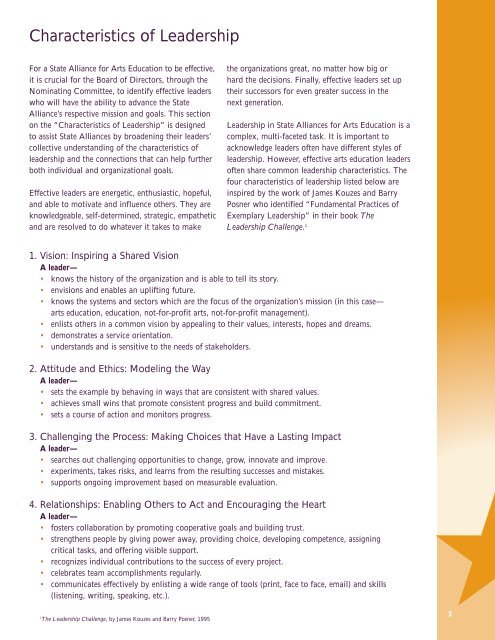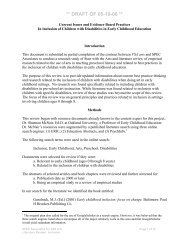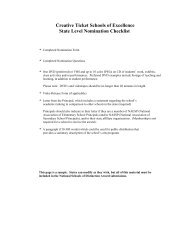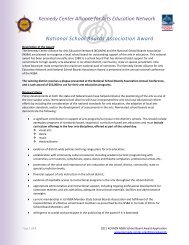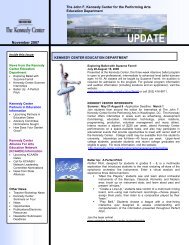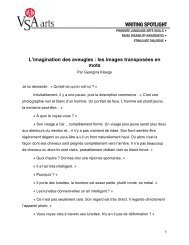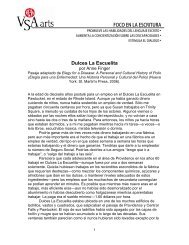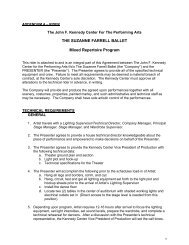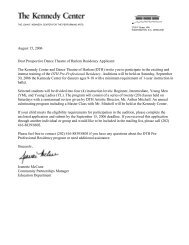KCAAEN Leadership Kit - The John F. Kennedy Center for the ...
KCAAEN Leadership Kit - The John F. Kennedy Center for the ...
KCAAEN Leadership Kit - The John F. Kennedy Center for the ...
Create successful ePaper yourself
Turn your PDF publications into a flip-book with our unique Google optimized e-Paper software.
Characteristics of <strong>Leadership</strong><br />
For a State Alliance <strong>for</strong> Arts Education to be effective,<br />
it is crucial <strong>for</strong> <strong>the</strong> Board of Directors, through <strong>the</strong><br />
Nominating Committee, to identify effective leaders<br />
who will have <strong>the</strong> ability to advance <strong>the</strong> State<br />
Alliance’s respective mission and goals. This section<br />
on <strong>the</strong> “Characteristics of <strong>Leadership</strong>” is designed<br />
to assist State Alliances by broadening <strong>the</strong>ir leaders’<br />
collective understanding of <strong>the</strong> characteristics of<br />
leadership and <strong>the</strong> connections that can help fur<strong>the</strong>r<br />
both individual and organizational goals.<br />
Effective leaders are energetic, enthusiastic, hopeful,<br />
and able to motivate and influence o<strong>the</strong>rs. <strong>The</strong>y are<br />
knowledgeable, self-determined, strategic, empa<strong>the</strong>tic<br />
and are resolved to do whatever it takes to make<br />
<strong>the</strong> organizations great, no matter how big or<br />
hard <strong>the</strong> decisions. Finally, effective leaders set up<br />
<strong>the</strong>ir successors <strong>for</strong> even greater success in <strong>the</strong><br />
next generation.<br />
<strong>Leadership</strong> in State Alliances <strong>for</strong> Arts Education is a<br />
complex, multi-faceted task. It is important to<br />
acknowledge leaders often have different styles of<br />
leadership. However, effective arts education leaders<br />
often share common leadership characteristics. <strong>The</strong><br />
four characteristics of leadership listed below are<br />
inspired by <strong>the</strong> work of James Kouzes and Barry<br />
Posner who identified “Fundamental Practices of<br />
Exemplary <strong>Leadership</strong>” in <strong>the</strong>ir book <strong>The</strong><br />
<strong>Leadership</strong> Challenge. 1<br />
1. Vision: Inspiring a Shared Vision<br />
A leader—<br />
• knows <strong>the</strong> history of <strong>the</strong> organization and is able to tell its story.<br />
• envisions and enables an uplifting future.<br />
• knows <strong>the</strong> systems and sectors which are <strong>the</strong> focus of <strong>the</strong> organization’s mission (in this case—<br />
arts education, education, not-<strong>for</strong>-profit arts, not-<strong>for</strong>-profit management).<br />
• enlists o<strong>the</strong>rs in a common vision by appealing to <strong>the</strong>ir values, interests, hopes and dreams.<br />
• demonstrates a service orientation.<br />
• understands and is sensitive to <strong>the</strong> needs of stakeholders.<br />
2. Attitude and Ethics: Modeling <strong>the</strong> Way<br />
A leader—<br />
• sets <strong>the</strong> example by behaving in ways that are consistent with shared values.<br />
• achieves small wins that promote consistent progress and build commitment.<br />
• sets a course of action and monitors progress.<br />
3. Challenging <strong>the</strong> Process: Making Choices that Have a Lasting Impact<br />
A leader—<br />
• searches out challenging opportunities to change, grow, innovate and improve.<br />
• experiments, takes risks, and learns from <strong>the</strong> resulting successes and mistakes.<br />
• supports ongoing improvement based on measurable evaluation.<br />
4. Relationships: Enabling O<strong>the</strong>rs to Act and Encouraging <strong>the</strong> Heart<br />
A leader—<br />
• fosters collaboration by promoting cooperative goals and building trust.<br />
• streng<strong>the</strong>ns people by giving power away, providing choice, developing competence, assigning<br />
critical tasks, and offering visible support.<br />
• recognizes individual contributions to <strong>the</strong> success of every project.<br />
• celebrates team accomplishments regularly.<br />
• communicates effectively by enlisting a wide range of tools (print, face to face, email) and skills<br />
(listening, writing, speaking, etc.).<br />
1<br />
<strong>The</strong> <strong>Leadership</strong> Challenge, by James Kouzes and Barry Posner, 1995<br />
3


